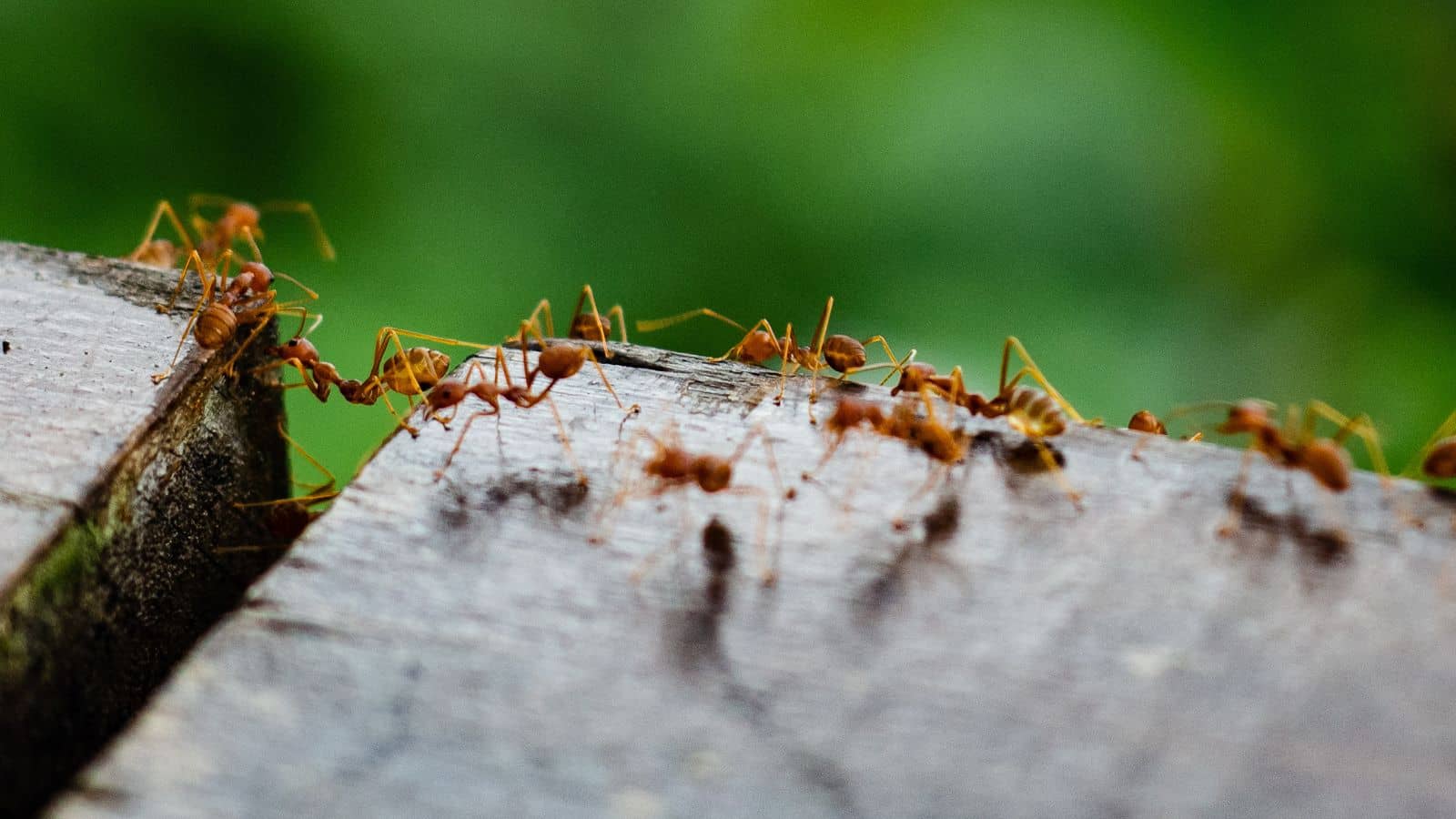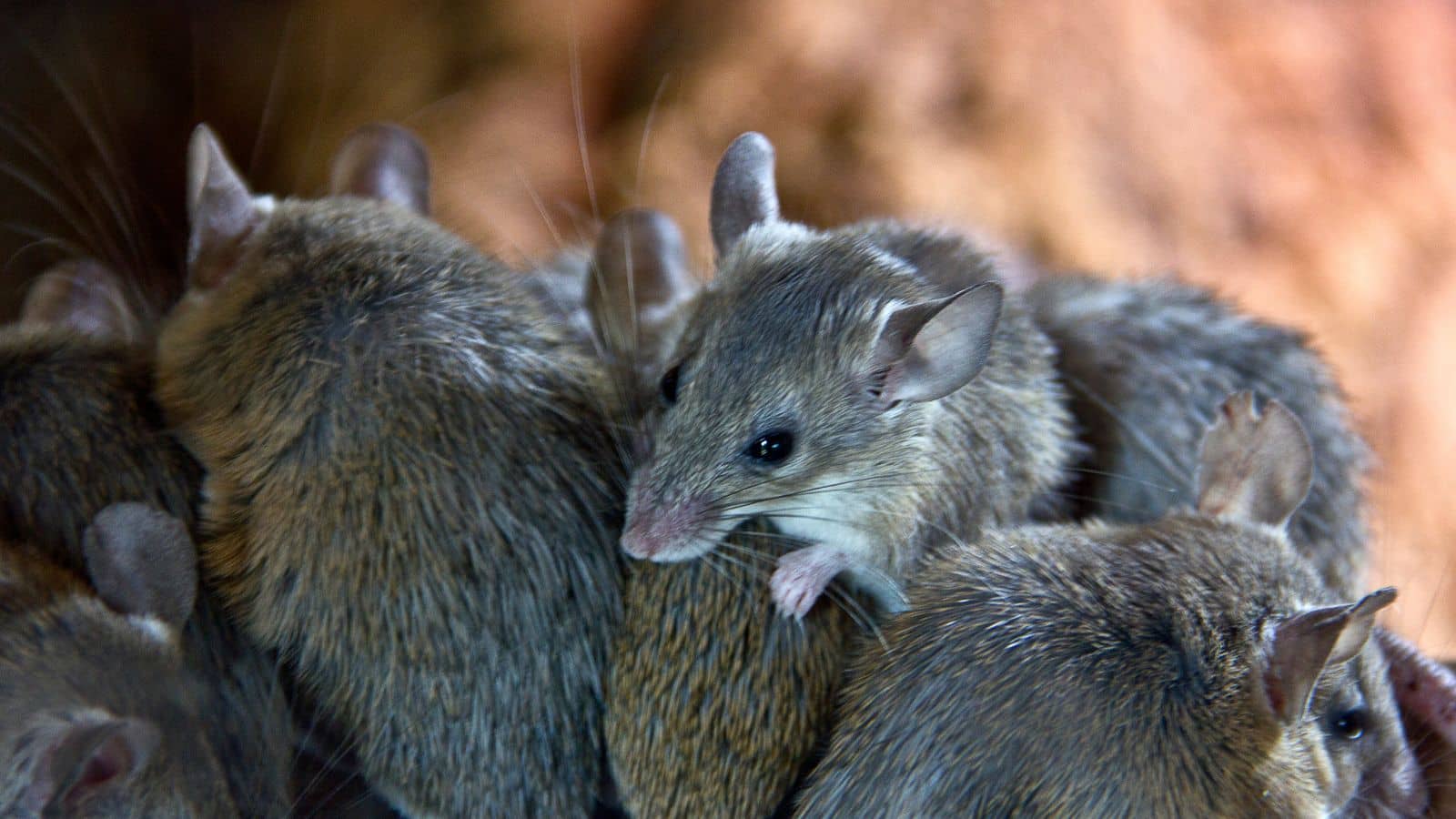To the novice, they all look the same, but the trained eye can discern whether or not that flying insect threatening to spoil your picnic is a bee, a wasp, or a hornet. Here, we describe their distinguishing features, explain which deserves more caution, and what to do when you encounter a nest.
Bees
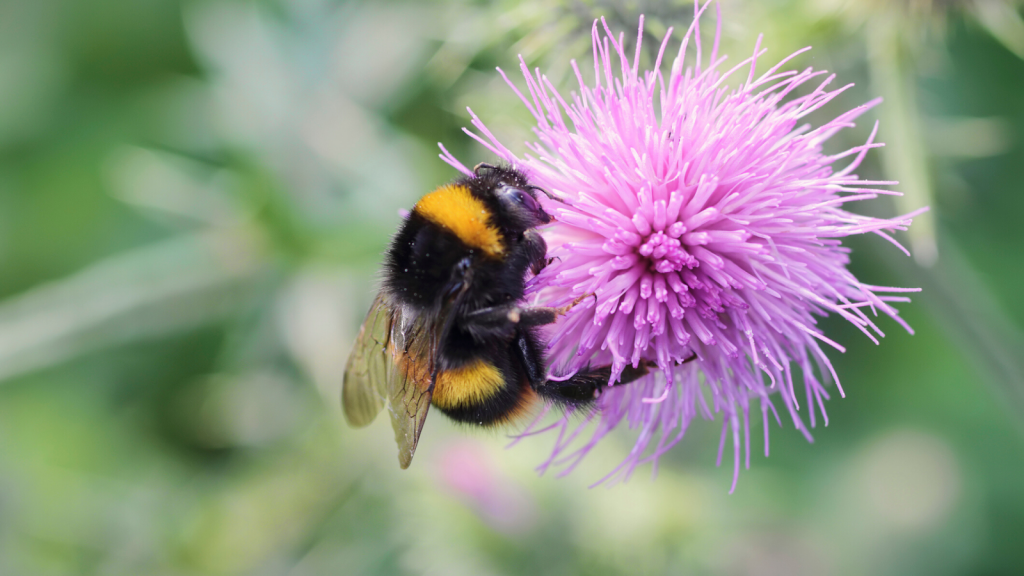
There are more than 20,000 known species of bees, so let’s focus on the three you’re most likely to encounter: bumblebees, honey, and carpenter bees.
Bumblebees
Defining characteristics: Large and round and adorably fuzzy with yellow and black bands.
Bumblebees make their home underground or within loose piles of fibrous material, such as insulation or grass clippings. Their colonies are small. Bumblebees only attack if you disturb their nest. They can sting multiple times without dying.
Honey bees
Defining characteristics: Oval-shaped with golden yellow and brown bands.
Wild honey bees build large, waxy hives in the hollows of trees or logs, but they’ll take up residence inside your attic, too. Colonies contain as many as 60,000 bees. Honey bees will defend their hive to the death, literally — they die after stinging. In addition to hives, you also should use caution around swarms. When a colony moves out of its parent hive, a swarm will temporarily settle on a structure such as a telephone pole, branch, fence, or playground equipment until they find a new home. If you find a swarm, keep your distance and wait it out. They’ll leave in about a day.
Carpenter bees
Defining characteristics: Large and round like bumblebees, but the rear abdomens are black and shiny. Males have a yellow face; females have a black face.
Carpenter bees, or wood bees, earn their name from boring into wood to make their nests. They make clean, sharp tunnels that almost appear manmade, such as with a drillbit. When the nest is complete, the female will seal off one end of the tube with a plug of chewed wood pulp. Carpenter bees are attracted to weathered and unpainted wood, so consider painting your eaves, porches, decks and other structures. Males are aggressive, but they don’t have stingers. Females can sting but rarely do.
Wasps
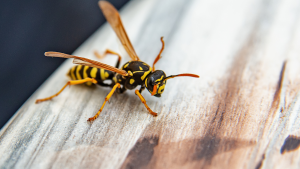
Defining characteristics: Narrow, pinched waist, and usually black with yellow, white, or orange markings.
Wasps make papery nests resembling upsidedown umbrellas. You’ll find them in eaves, gutters, bushes, and fences. The yellowjacket, a close cousin of the wasp, makes its nest underground. Of the two, the yellow jacket is the one most likely to ruin your picnic. Yellowjackets are meat-eaters, so they’ll be attracted to your burgers and hotdogs. Both will sting, but only the more aggressive yellowjacket will strike unprovoked.
Hornets
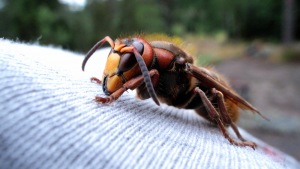
Defining characteristics: The European hornet, the most common in the U.S., is large and burgundy with yellow stripes on the abdomen. The bald-faced hornet is mostly black but with a distinctive white mask.
European hornets make papery nests inside the cavities of trees, open pipes, and attics. Bald-faced hornets, on the other hand, like to create hives in exposed areas, such as tree branches, shrubs, your porch roof, and eaves. Both will sting if they feel threatened, and they’ll sting repeatedly.
How to prevent wasps and hornets from infesting your home
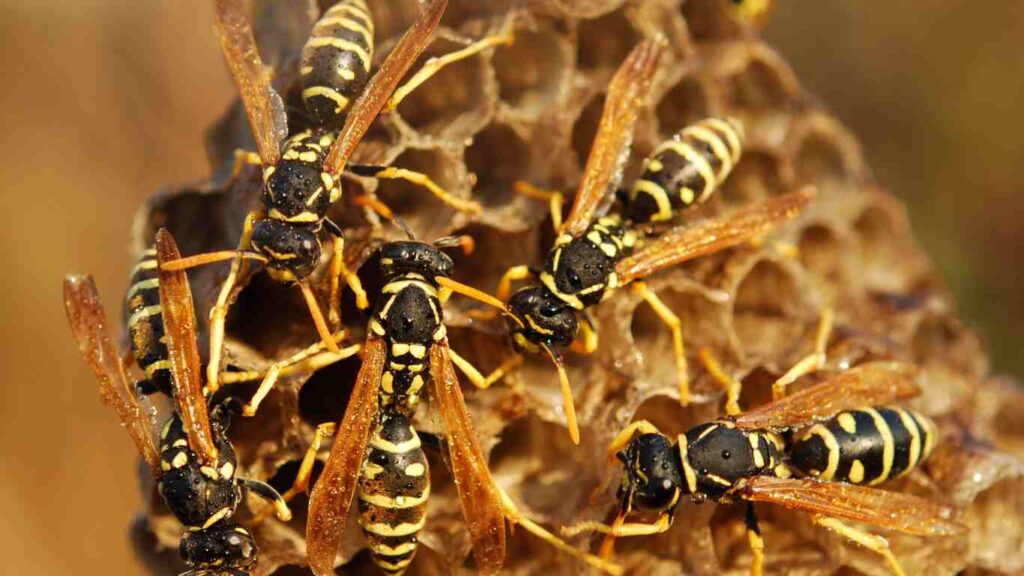
California’s sunny climate attracts more than just residents—it’s also a paradise for wasps and hornets. These stinging insects thrive in warm temperatures, often building nests in or near homes.
While they play an essential role in the ecosystem by controlling other pest populations, they can quickly become a nuisance or even a danger when they invade your property.
Here’s how you prevent wasps and hornets from infesting your home, with actionable tips and insights tailored for California homeowners.
Why Are Wasps and Hornets Attracted to Your Property?
Before diving into prevention tips, it’s essential to understand what draws these insects to your home. Wasps and hornets are often attracted to areas that provide:
- Food Sources: Sweet beverages, fruit trees, garbage, and outdoor eating areas are magnets for these pests.
- Shelter: Eaves, attics, sheds, and garages provide the perfect space for nest building.
- Water: Standing water, bird baths, or leaky pipes can attract wasps and hornets looking for hydration.
- Warmth: California’s climate offers ideal nesting conditions during spring and summer.
By addressing these attractants, you can significantly reduce the likelihood of an infestation.
10 Proven Tips to Prevent Wasps and Hornets
Seal Entry Points
Inspect your home for cracks, gaps, and holes in walls, windows, and roofs. Use caulk or weatherstripping to seal these openings, especially around vents, attic access points, and exterior siding. This prevents wasps and hornets from finding their way indoors.
Remove Food Sources
- Keep garbage cans tightly sealed.
- Clean up food spills and sugary residues immediately.
- Regularly harvest ripe fruits from trees and pick up any that have fallen to the ground.
- Cover drinks and food when dining outdoors to avoid attracting wasps.
Eliminate Standing Water
Wasps and hornets need water to survive. Check your property for standing water, such as clogged gutters, puddles, or leaky pipes, and address these issues promptly.
Install Insect Screens
Add fine-mesh screens to windows, doors, and vents. This serves as a barrier to prevent wasps and hornets from entering your home while allowing ventilation.
Keep Your Yard Tidy
- Trim back overgrown bushes, shrubs, and tree branches to remove potential nesting sites.
- Clear yard debris like piles of leaves, wood, or unused equipment, as these can offer shelter to wasps and hornets.
Use Decoy Wasp Nests
Wasps and hornets are territorial and tend to avoid areas where other colonies are established. Hanging decoy nests in strategic areas, such as your porch or backyard, can discourage them from nesting on your property.
Apply Wasp-Repellent Scents
Certain scents, such as peppermint, eucalyptus, or citronella, naturally repel wasps and hornets. Consider planting these herbs in your garden or using essential oils to create a DIY spray for outdoor areas.
Regularly Inspect Your Property
Early detection is key to preventing a full-blown infestation. Check your property regularly for signs of nests, especially under eaves, in sheds, and in attic spaces. If you spot a nest early, it’s easier to remove.
Avoid Leaving Pet Food Outdoors
Pet food can attract wasps and hornets. Feed your pets indoors or remove uneaten food promptly if they eat outside.
Schedule Professional Inspections
Hiring a pest control professional for routine inspections ensures your property stays pest-free. Experts can spot vulnerabilities and provide tailored solutions before problems escalate.
What to Do if You Spot a Wasp or Hornet Nest
Finding a nest on your property can be alarming, but it’s crucial to handle the situation carefully to avoid getting stung. Here’s how to proceed:
- Stay Calm: Avoid swatting at wasps or hornets, as sudden movements can provoke them.
- Keep a Safe Distance: Do not attempt to remove a nest on your own, especially if it’s large or located in a hard-to-reach area.
- Call a Professional: Pest control experts have the tools and expertise to safely and effectively remove nests without endangering your family.
How OPP Can Help Protect Your Home
At OPP, we understand the unique pest challenges California homeowners face. Our wasp and hornet prevention services are designed to keep your home safe year-round. Here’s what sets us apart:
- Local Expertise: We know the common wasp and hornet species in California and their nesting habits.
- Eco-Friendly Solutions: Our methods are environmentally responsible, prioritizing the safety of your family, pets, and the planet.
- Fast and Reliable Service: Whether you need an inspection or emergency nest removal, our team is here to help.
DIY Wasp and Hornet Prevention vs. Professional Services
While DIY measures are effective for prevention, professional pest control offers long-term peace of mind. Here’s why hiring a pro might be the best choice:
- Safety: Professionals use specialized equipment to handle nests without putting you at risk.
- Thoroughness: Experts ensure that every nest and potential attractant is addressed.
- Cost-Effectiveness: Preventing infestations now can save you from costly damage and treatments later.
When to Call a Professional
If you’ve tried preventive measures but are still seeing wasps or hornets, it’s time to seek professional help. Common signs that indicate it’s time to call a pest control expert include:
- Frequent sightings of wasps or hornets near your home.
- A nest forming in or near your property.
- Family members or pets experiencing stings.
- An increase in wasp or hornet activity despite DIY efforts.
Don’t wait for the problem to escalate. A professional inspection can identify the root cause and provide a tailored solution.
Preventing wasps and hornets from infesting your home doesn’t have to be overwhelming. By understanding what attracts these insects and implementing the tips outlined above, you can create a safer, pest-free environment for your family.
However, prevention is only half the battle. If you suspect a wasp or hornet problem, OPP is here to help. Contact us today to schedule a free inspection and take the first step toward reclaiming your home from unwanted pests.
What to Do if You’re Stung?
If you are stung, take the following steps immediately, as recommended by the American Academy of Dermatology:
-
Remove the stinger with your fingernails if possible. Never use tweezers. They can squeeze more venom out of the stinger.
-
Wash sting on site and apply ice to minimize swelling.
-
Take an over-the-counter medication such as acetaminophen or ibuprofen.
-
If the swelling moves to other parts of the body, go to the emergency room immediately. Some stings can be life-threatening.
Bottom line: If you encounter a bee of any kind, it’s best to leave it alone. Most bees won’t sting unless provoked. However, wasp nests near your home should be removed by a professional. Our Sacramento and Fresno wasp control experts will remove any danger to keep your property safe ASAP. To make your appointment with Official Pest Prevention, (877) 711 2847.


